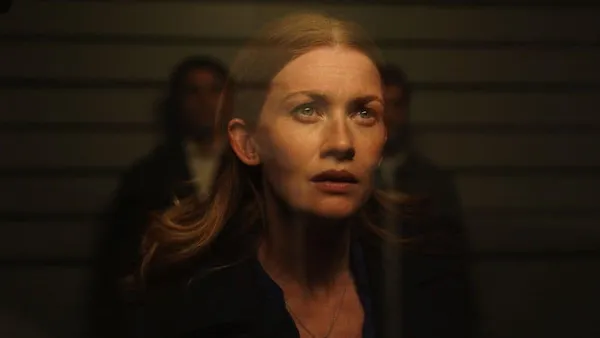 |
| Mireille Enos in Never Here |
The story of an artist who gets out of her depth after reporting a crime witnessed by her lover, Never Here is a many layered tale that explores artistic obsession and difficult moral territory. It stars Mireille Enos as the troubled Miranda and it’s notable for featuring the final performance of Sam Shepard’s career. Almost a year after it was first released in the US, it’s finally getting a UK release – a big deal to director Camille Thoman, who once studied at the University of Bristol. I asked her if the news came as a surprise.
“I fought for it, pretty hard,” she says, “because I felt so much of my orientation as a filmmaker was formed in the UK and I gravitate stylistically towards it and more European sophisticated cinema. That sounds so snobbish!” She laughs. “So no, it wasn’t a total surprise but I’m really happy.”
Preparing for the interview, I watched the film again for the first time in a year and found a lot of new things in it. I remark that in many ways it feels more like a piece of exhibition art than like a conventional film.
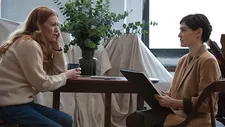 |
| The artist in interview |
“I was definitely toying with that idea, very much,” she says. “Is this film her [Miranda’s] art piece, ultimately? Who’s in control? On a plot level there’s a lot of cat and mouse stuff going on and then a lot of the dynamics between the camera and the actor and the camera and the spectator are also dynamics of control.”
Without wanting to give too much away, there’s also a brief scene in the final credits which adds to that uncertainty.
“Totally. That’s why I put that in there. It’s like, has she actually been in control much more than we knew?”
Camille came to the film after making documentary The Longest Game. Was she interested in the overlap between Miranda’s art, which involves exploring the lives of strangers, and what filmmakers do when they enter other people’s lives?
“Was I consciously thinking about it? Well I was, very much, on a cinematic level. I’m always thinking about the spectator... I’m intending to enter the spectator in this film, and in other work I’ve done in the past, almost sideways, sometimes, with the camera. Like, basically keep their brain busy with the plot and then have the visuals of the film have a dialogue with the audience’s body, almost, or subconscious. And that dialogue is of a different content than what relates to the plot.”
The plot is reminiscent of Eighties neo-noir The Bedroom Window, something she acknowledges, but the ay she uses it is very different. Did she basically intend it to distract viewers whilst other aspects of the film sneaked up on them?
“Yes, definitely. That was my intent.”
It’s also a film that feels very personal, at least in tone. Does she relate to Miranda?
“Yes and no. I don’t share a lot of character adjectives with Miranda. When I was writing her, the way that she interacts with the world is very different from me, and certainly as an artist she goes to lengths that I would never go. “But I think there’s a way in which she’s cobbled together a life for herself with an undercurrent of a traumatic event, and that I related to, this kind of living in a world that is pieced together post-trauma... It was an experience of mine that I think pervades the mood of the film.”
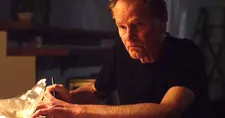 |
| Sam Shepard in Never Here |
That’s part of what makes Miranda intriguing though, isn’t it? That she goes to extremes?
“She’s so interesting! I think people who go to extremes are very interesting and I do relate to this almost religious feeling about being an artist. I’m trying not to do this now, I’m trying to be a little more balanced, but you know, just put the art into the world and that comes first and that’s what matters and there is something almost like a priest or a nun about it that you encounter in other artists and I know in myself, of service, and in her case she goes so crazy with that idea. Her whole life is put up for auction in ‘service’ to her work.
“So yeah, I think that’s really interesting – and also the fact that she crosses all these moral lines. Or does she? You know, depending on why you speak to. I think that’s also very interesting.”
She becomes so obsessed that watching the film from her perspective is like having an unreliable narrator, I suggest.
“A hundred percent,” says Camille.
There’s an extra emotional weight to parts of the film now because they feature Sam Shepard’s last work, shortly before his death. I ask if she had any inkling that this would be one of his final performances.
“No. I was not aware at all,” she says with perceptible sadness. “He was a deeply inspiring person to be around and he continues to inspire me. He was on set for a very short period – I think it was seven days – and I am still inspired by those seven days. I take a lot with me. And I think he did that to everybody on the set, or most of us. There was just a feeling of all of us really wanting to do our best when he was around – and of course we did our best all the time because the crew and the cast I had, they were extraordinary – but there was an extra special thing when he was on set.”
How did she go about getting such intense performances from her cast?
“My dialogue with every actor is different. First of all I think I just cast really fine actors... With Sam, my dialogue with him was very practical, intellectual. With Mireille, my dialogue with her sometimes was story-based and practical and intellectual, and sometimes we had a more visceral back and forth. Each actor had a lot of input into who the character was, why they were there, what they were doing there, where they would be in the room. I believe in actors having maximum power.”
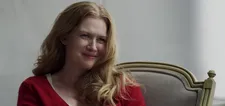 |
| Miranda moments |
Did that influence the way that the story and themes developed during the shoot?
“Not in this script. I very much like to work that way but not in this script. There wasn’t a lot of room for improvisation from a script perspective outside of Vincent Piazza, who did improvise and improvised really well. But sometimes you have to say the line that’s written because there’s so much theme in the movie – it could go off the rails really quickly, the structure of this film, and it’s actually quite finely honed.
“My preference with my work is to let themes and dialogue emerge and in this film we did that to a certain degree but it was limited. But I knew going into it that I wanted to have room in the schedule for what we called ‘Miranda moments.’ The Miranda moments would be totally improvised and they’d be her sitting reading a book, they’d be her putting on make-up, her walking around her apartment, her talking to the camera, her doing some piece of her work, and they were so necessary to the film, so many of them got used. About 80% of them got used and they ended up being very important to the whole tone of the film. And those were completely improvised.”
How did Camille maintain that degree of control when working, in some scenes, with a dog?
“With great difficulty!” She laughs. “I mean, working with animals takes time, for sure... Not only is Mireille an extraordinary actress but she’s an extraordinary person; she’s a very warm, empathetic person. There’s a scene that actually got cut from the film when Miranda screams at the dog and goes like ‘You’re not my dog!’ Mireille was like ‘I’m not going to put that kind of energy on this innocent animal who doesn’t understand what’s happening. She was an excellent kind of actor-trainer and really had the dog in her control, so to speak, and then also she was very empathetic with the dog as well.”
Something else that’s very striking about the film is its visual design, especially the use of fragmented images. How did that develop?
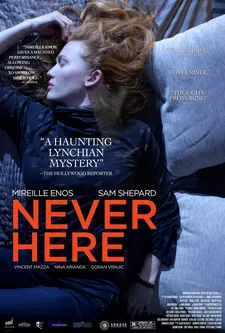 |
| Never Here poster |
“The fragmented images were very key to how we approached shooting the film. It just fit very much with how I saw the film in my head, that there should be a character half in and half out of the frame, or at the side of the frame. At some level it’s about drawing attention to the frame, I think, and also literally cutting the body with the frame. I mentioned earlier having a dialogue with the spectator’s subconscious or body, and that’s an example of that. If you’re in a world that’s cutting off half of the character’s body, that says something about the world that you’re in and affects you when you’re sitting in your chair watching it. It was something that I really wanted, going into it, and I had a really, really wonderful DP, Sebastian Winterø, who brought his gorgeous visual style to everything we did. It was a successful collaboration.”
How much of the distinctive use of colour in the film was hers, and how much his?
“I could see a lot of the film in my head before we shot it. But every film is a collaboration and without Sebastian I think a lot of my colour ideas would have been lost. He had them perfectly executed,” she says. “I had a pretty strong idea going into the film what it needed to look like and the idea that we were really dealing with reds and greens and also borrowing a lot from the Seventies, in terms of the browns and the oranges of the colour palette. That was something that was born kind of out of the script stage.”
So how close is the final film to the one she had in her head?
“Very close. Very, very close. I mean, I feel like, basically the movie I had in my head got made.”
That’s very rare, I tell her – directors are always telling me about the compromises they’ve had to make. She’s surprised but puts the success of this film down to the skill of her team.
“The movie in my head got made because I was surrounded by people of extraordinary capacity. Technical capacity, emotional capacity and also, part of the movie in my head allowed for chaos. So at the last minute we would lose a location or something and yet it all kind of worked out. So even where it ended up being different technically from the movie in my head it was still the same as the movie in my head. I think that was partially because of the quality of the people who actually made the film and also the fact that I instilled in our team the notion that chaos was acceptable. So when things went off track we were still on track, and that ended up really serving the film well.”
Is she working on another film now?
“Yes, there’s a bunch of stuff I’m working on at the moment... I’m working on an elevated horror script in the vein of The Witch, Hereditary, It Follows – that kind of playing field – and then I’ve got another few projects that are early days still but that I’m very excited about.”
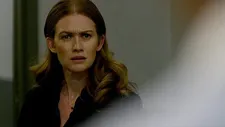 |
| Shifting perspectives |
Is that usual for her, working on several things at once?
“No, actually, this is really new. But I feel like I’m going through a period of self discovery as an artist, you know, what do I want to do next? And so I’m dipping my toes in a few different genres in terms of what I’m writing. And then the projects that are coming to me are also very different from Never Here and I really like that.”
Does she learn more from working on different things?
“I find that everything I ever do I learn from. And it’s when I forget that I’m learning from it that I get into trouble.”
Never Here is in UK cinemas this week.





















